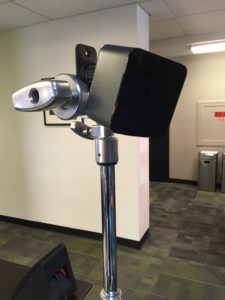It’s been an exciting few weeks at Stimulant as the AR/VR hardware we pre-ordered months ago has finally started shipping. While we’re still in the midst of getting our hands dirty with HoloLens, we just received the long-awaited HTC Vive last week!
Vive has been creating a lot of buzz with Lighthouse, the ingenious 3D position tracking system created by Valve. You can read more in depth about how it works elsewhere (or watch a video), but in a nutshell, Lighthouse floods the room with infrared light, which is detected by sensors on Vive’s headset and controllers to determine their location and orientation in space.

One of the “Lighthouse” infrared emitters
This involves setting up two Lighthouse boxes in diagonally opposite corners of your designated VR space, about six or seven feet above the floor. While this might sound like an elaborate setup, it’s pretty easy in practice, and requires virtually (pun intended) no calibration; the SteamVR app walks you through turning things on and marking edges of your VR space with a controller. These edges show up as subtle virtual boundaries to guard you against running into physical things while you’re immersed in an experience.
We quickly realized that while the headset’s graphics and audio were enough to create a good immersive experience, it was really the flawless tracking and haptic feedback on the controllers that completed it. The simple gesture of blowing balloons (by pressing a button on the controller) and hitting them by waving your controller in an infinite virtual space brought joy to pretty much everyone in the office. The design and placement of buttons on these controllers make them quite versatile, and make object manipulation in the VR world almost as intuitive as real world.

The HTC Vive controllers
The implementation of haptic feedback in the controllers is extremely well done. For example, you can pick up a virtual archery bow with one controller, and while pulling a virtual arrow with another, the second controller vibrates more as increasing tension is placed on the virtual bow string. We quickly got lost in the many “mini” VR worlds of The Lab, full of rich new interactions tailored for VR, like being able to cover vast virtual distances (while still being in a confined real space) by “teleporting” and selecting sub-menus by pointing a controller at a virtual button on another controller (a great example of non-fatiguing asymmetric bimanual interaction).

The obvious limitation of any VR experience, on the Vive or any other VR platform, is that they feel isolating in a social/public setting; it’s a very intimate, single-person experience. Maybe being able to track more than one headset in the same space could overcome this, but having multiple users within a VR “arena” (the area within the Vive’s Lighthouse sensors) could also lead to ergonomic concerns, like bodily collision between two users. Unlike HoloLens, but like other VR headsets, the HTC Vive is tethered to a PC, restricting movement and range. There are also hygiene concerns in shared-use scenarios, since the headset rests on one’s hair and requires in-ear audio monitoring.
Overall though, we think that the Vive succeeds in creating an immersive VR experience due to its innovative tracking system and controller design. It remains to be seen how other consumer grade headsets like the new Oculus Rift and PSVR compare with it. But rest assured, we will be posting our impressions as we try them out in the near future!







